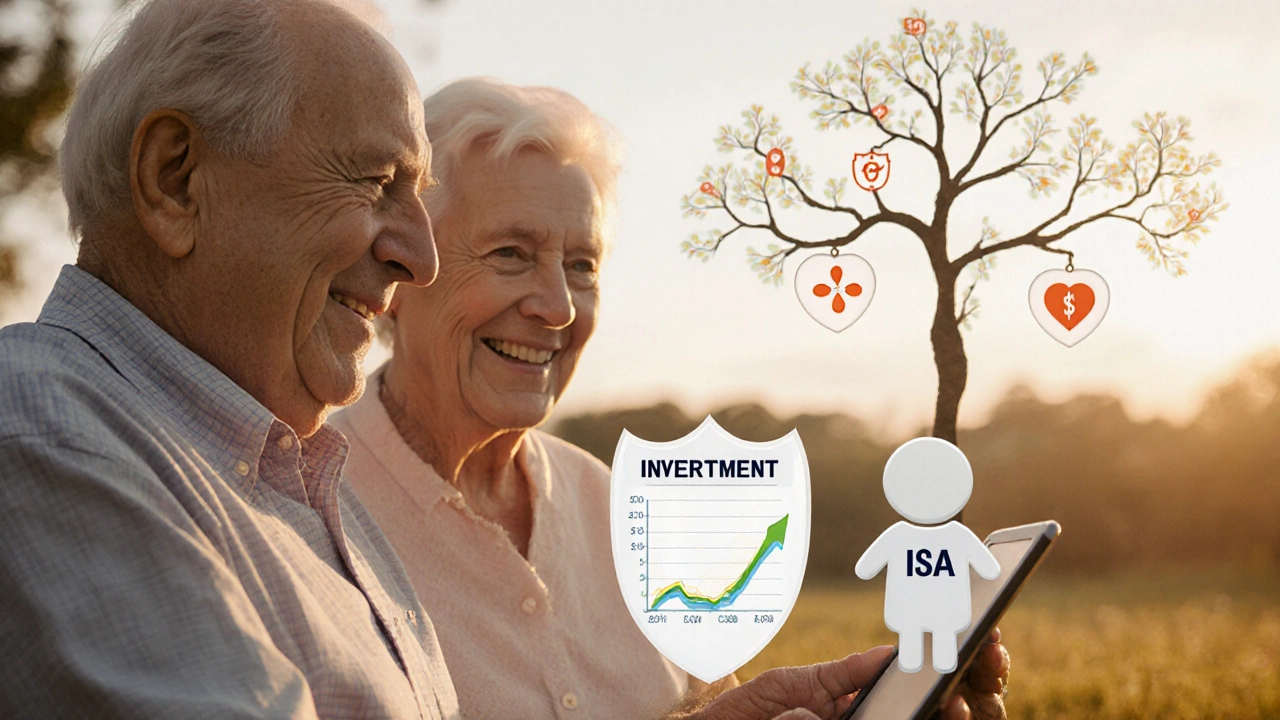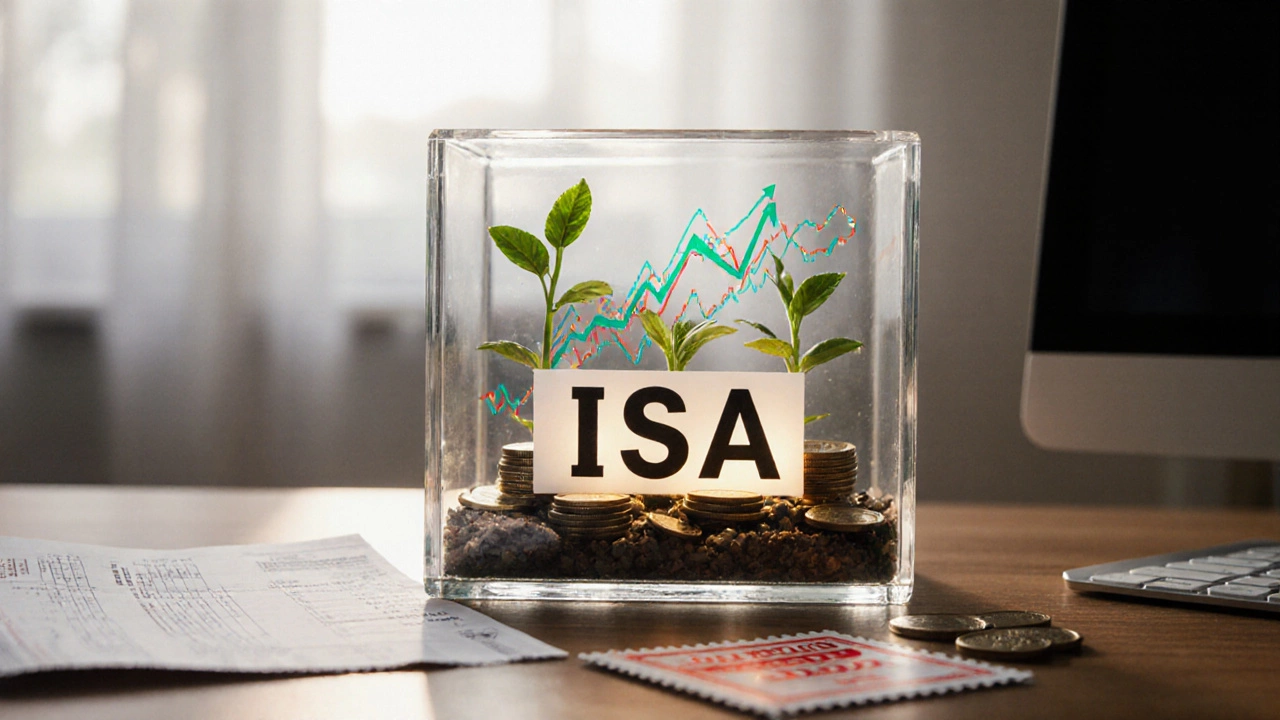ISA Tax Savings Calculator
Calculate how much you could save in taxes by investing in an ISA versus a regular taxable account.
The UK has a £20,000 annual ISA allowance in 2025. Any growth inside your ISA is completely tax-free.
This calculator compares your potential returns using the tax-free ISA wrapper versus a taxable investment account.
Your Tax-Free Investment Growth
Total value after years:
Total tax savings:
Compared to Taxable Account
Without the tax-free ISA wrapper, your investment would face significant tax on both dividends and capital gains.
Total value in taxable account:
Difference (with tax-free benefit):
How this works: The ISA keeps your growth tax-free. With a taxable account, you'd pay tax on dividends and capital gains at your rate, which reduces your final value.
If you’ve heard that ISAs are tax-free, you’re not wrong-but you might not know how or how much that actually saves you. ISAs aren’t magic. They don’t erase taxes from your income. But they do lock in tax advantages on the money you put in and grow inside them. And in 2025, that’s still one of the most powerful tools in the UK’s personal finance toolbox.
What exactly is an ISA?
An ISA stands for Individual Savings Account. It’s not a single product. It’s a government-backed wrapper that protects your money from tax. You can put cash in it, invest in stocks and shares, or even buy innovative finance loans. But no matter the type, the core rule stays the same: anything you earn inside an ISA-interest, dividends, or capital gains-is free from UK income tax and capital gains tax.
Think of it like a sealed box. You put money in. It grows. You take it out. The government doesn’t take a cut. That’s the whole point.
How much can you save tax-free each year?
In the 2025/2026 tax year, the ISA allowance is £20,000. That’s the total amount you can put into any combination of ISAs in a single tax year (April 6 to April 5). You don’t have to use it all. But if you don’t, you lose it. There’s no carryover.
You can split that £20,000 however you like:
- £15,000 in a Cash ISA, £5,000 in a Stocks and Shares ISA
- £20,000 in a Stocks and Shares ISA only
- £10,000 in a Lifetime ISA, £10,000 in a Cash ISA
But here’s the catch: you can only pay into one of each type per tax year. So you can’t have two separate Stocks and Shares ISAs open and contributing to both. You can hold multiple ISAs from different years, but you can only add new money to one of each kind annually.
What types of ISAs are tax-free?
There are four main types of ISAs in 2025, and all of them are tax-free inside the wrapper:
- Cash ISA: Like a savings account, but interest is tax-free. Great for short-term goals or if you’re risk-averse. Rates vary, but top providers offer around 4.5% AER in 2025.
- Stocks and Shares ISA: Lets you invest in funds, shares, bonds, or ETFs. Any dividends you receive and any profit when you sell are tax-free. This is where most long-term wealth is built.
- Innovative Finance ISA: For peer-to-peer lending. You lend money to businesses or individuals through platforms like Funding Circle. Returns are tax-free, but risk is higher than cash or stocks ISAs.
- Lifetime ISA: For under-40s. You get a 25% government bonus on up to £4,000 per year (so £1,000 extra). But you can only use it to buy your first home or withdraw after age 60. Withdrawals for anything else before 60 cost you the bonus plus a 25% penalty.
None of these accounts charge tax on growth, income, or withdrawals. That’s the tax-free part.
What’s not tax-free about ISAs?
Let’s clear up a common myth: ISAs don’t reduce your income tax bill. They don’t lower your taxable earnings. You still pay income tax on your salary or pension before you put money into an ISA.
Example: You earn £50,000 a year. You pay £10,000 in income tax. You then put £20,000 into a Stocks and Shares ISA. That £20,000 came from your after-tax income. The ISA doesn’t give you a refund on the £10,000 you already paid. But anything that money earns inside the ISA-whether it’s 5% growth or £1,000 in dividends-is completely untouched by tax.
Also, ISAs don’t protect you from inflation. A Cash ISA earning 4% while inflation is 3% still loses you 1% in real terms. That’s why many people use Stocks and Shares ISAs for long-term goals.
What happens when you withdraw money?
You can take money out of any ISA at any time. No penalties. No questions asked. And you don’t pay tax on the withdrawal. That’s a big deal.
But here’s the twist: if you take money out, you can’t put it back in the same tax year without using part of your next year’s allowance. For example, if you put in £20,000 and then take out £5,000 in March, you can’t add another £5,000 until April 6, 2026. You’ve used your full £20,000 for the year.
This is a trap many people fall into. They think they can recycle their allowance. They can’t. Once you withdraw, that space is gone for the year.

Do you pay tax on ISA transfers?
No. If you want to move your ISA from one provider to another-say, from a low-interest Cash ISA to a better-paying one-you can do it without touching the money. Just ask your new provider to transfer it. The old provider sends it directly. You don’t withdraw it yourself. That way, you keep your tax-free status and don’t risk blowing your allowance.
Never withdraw and then re-deposit. That counts as a new contribution. And if you’ve already hit your £20,000 limit, you’ll be penalized.
Are ISAs protected if the provider fails?
Yes. Cash ISAs are protected under the Financial Services Compensation Scheme (FSCS) up to £85,000 per person, per institution. That’s the same as regular savings accounts.
Stocks and Shares ISAs are protected differently. The money you invest is held in your name, not the provider’s. So if the platform goes bust, your shares and funds are still yours. You just need to move them to a new provider. The FSCS can also cover you up to £85,000 if the platform fails to properly safeguard your assets.
Who can open an ISA?
You must be:
- A UK resident (or a Crown servant working overseas)
- Aged 16 or over for a Cash ISA
- Aged 18 or over for a Stocks and Shares, Innovative Finance, or Lifetime ISA
You can’t open an ISA if you’re a non-resident. If you move abroad, you can keep your existing ISA open and it stays tax-free. But you can’t add new money to it.
Do you need to declare ISAs on your tax return?
No. You don’t. HMRC already knows what you’ve paid into your ISA because providers report it to them. You don’t need to report ISA income or gains on your tax return-even if you’re a higher-rate taxpayer or have other investments.
This is a huge advantage over regular investment accounts. Outside an ISA, you’d need to track capital gains and dividends and report them if you exceed your annual exemption (£3,000 for capital gains, £1,000 for dividend income in 2025/26).

What’s the real benefit of an ISA?
Let’s say you invest £20,000 in a Stocks and Shares ISA in 2025 and it grows at 6% a year. After 20 years, you’ve got about £64,000. If that same money was outside an ISA, you’d owe tax on dividends and capital gains. At a 32.5% dividend tax rate and 20% capital gains tax, you’d lose roughly £18,000 in taxes over that period.
That’s not theoretical. It’s math. And it’s why people who start early and use ISAs consistently end up with significantly more wealth.
Can you have more than one ISA?
You can have multiple ISAs from different years. For example, you might have a Cash ISA from 2020, a Stocks and Shares ISA from 2022, and a Lifetime ISA from 2024. You can keep them all open. But each tax year, you can only pay new money into one of each type.
It’s common to have several ISAs. The key is not to accidentally pay into more than one of the same type in the same year.
What happens to your ISA when you die?
Your ISA stays tax-free for your beneficiaries. If you die, your spouse or civil partner can inherit your ISA allowance. They get an additional ISA allowance equal to what you had in your ISA at death. This is called the Additional Permitted Subscription (APS). They can use it to transfer your ISA into their own name without affecting their own £20,000 limit.
For other beneficiaries, the ISA closes. The money becomes part of your estate and is subject to inheritance tax-but the growth inside the ISA up to the date of death remains tax-free.
Are ISAs completely tax-free?
Yes, but only on the growth and income inside the account. You don’t get tax relief on the money you put in-you pay income tax on your salary first. But once it’s in the ISA, any interest, dividends, or capital gains are completely free from UK tax.
Can I lose money in an ISA?
In a Cash ISA, your capital is protected up to £85,000. But in a Stocks and Shares ISA, the value of your investments can go down. You could lose money if the market falls. ISAs protect you from tax, not from investment risk.
Can I use my ISA allowance for my child?
No. Only the account holder can use their own ISA allowance. But you can open a Junior ISA for a child under 18. The annual limit is £9,000 in 2025/26, and it’s also tax-free. The child takes control at 18.
Do ISAs affect my state pension?
No. ISA income doesn’t count toward the income test for pension credit or other means-tested benefits. That makes ISAs one of the few ways to save without risking your entitlements later in life.
What if I pay into two ISAs in the same year by mistake?
HMRC will find out. They get reports from all ISA providers. If you accidentally pay into two of the same type, you’ll need to contact HMRC to fix it. You might lose the tax-free status on the excess amount. Don’t try to hide it-correcting it early avoids penalties.
Is it worth having an ISA if I’m not a higher-rate taxpayer?
Yes. Even basic-rate taxpayers benefit. The tax-free growth adds up over time. If you invest £20,000 a year for 30 years at 5% return, you’ll have over £1.6 million. Outside an ISA, you’d pay tens of thousands in tax on dividends and gains. It’s not just for the wealthy.
Next steps
If you’re not using your ISA allowance, you’re leaving free money on the table. Start by checking your current ISAs. Are they still paying competitive rates? Are you invested in the right mix for your goals? If you’re unsure, open a Cash ISA with a decent rate and start contributing £1,000 a month. Let the tax-free growth work for you.
Don’t wait until April. The earlier you invest, the more time your money has to grow. And remember: you can’t get back the allowance you missed. But you can start today.

